A) Ha
B) Hb
C) Hc
D) Hd
F) A) and C)
Correct Answer

verified
Correct Answer
verified
Multiple Choice
How many peaks would be observed for each of the circled protons in the compounds below? 
A) I = 8; II = 4; III = 3; IV = 3
B) I = 7; II = 4; III = 3; IV = 4
C) I = 7; II = 3; III = 3; IV = 3
D) I = 7; II = 4; III = 2; IV = 4
F) A) and C)
Correct Answer

verified
Correct Answer
verified
Multiple Choice
Which of the indicated protons in the molecules below would absorb furthest downfield in a 1H NMR spectrum? 
A) I
B) II
C) III
D) IV
F) C) and D)
Correct Answer

verified
Correct Answer
verified
Multiple Choice
Which of the indicated protons absorbs furthest downfield? 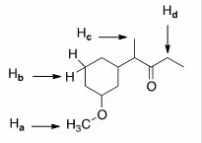
A) Ha
B) Hb
C) Hc
D) Hd
F) B) and C)
Correct Answer

verified
Correct Answer
verified
Multiple Choice
An unknown compound A has the molecular formula C12H16O.Compound A absorbs strongly in the IR at 1700 cm-1.The NMR spectral data for compound A are given below.What is the structure of compound A? 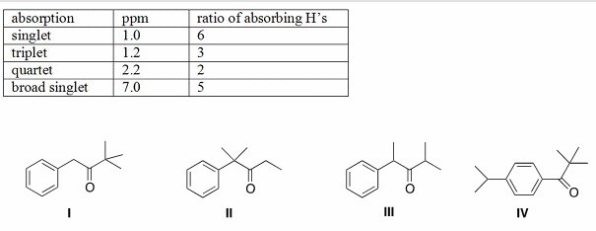
A) I
B) II
C) III
D) IV
F) A) and C)
Correct Answer

verified
Correct Answer
verified
Multiple Choice
How many different kinds of protons are present in each of the following compounds? 
A) I = 4; II = 3; III = 1
B) I = 4; II = 4; III = 1
C) I = 4; II = 4; III = 2
D) I = 3; II = 3; III = 1
F) A) and C)
Correct Answer

verified
A
Correct Answer
verified
Multiple Choice
Which of the following spectroscopy methods does not involve the interaction of organic molecules with electromagnetic radiation?
A) Nuclear magnetic resonance
B) Infrared spectroscopy
C) Mass spectrometry
D) Ultraviolet spectroscopy
F) B) and C)
Correct Answer

verified
Correct Answer
verified
Multiple Choice
How many peaks would be observed for each of the circled protons in the compounds below? 
A) I = 6; II = 2; III = 3
B) I = 7; II = 3; III = 3
C) I = 7; II = 1; III = 3
D) I = 7; II = 2; III = 3
F) C) and D)
Correct Answer

verified
Correct Answer
verified
Multiple Choice
Which of the following compounds would give rise to a 13C spectrum with 6 peaks? 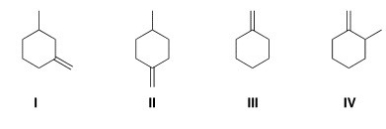
A) I
B) II
C) III
D) IV
F) A) and D)
Correct Answer

verified
B
Correct Answer
verified
Multiple Choice
What effect does increasing the operating frequency of a 1H NMR spectrum have on the frequency of an absorption in Hz?
A) Frequency of an absorption in Hz will also increase.
B) Frequency of an absorption in Hz will decrease.
C) Frequency of an absorption in Hz will remain the same.
D) It is not possible to predict the change in frequency of an absorption in Hz.
F) C) and D)
Correct Answer

verified
Correct Answer
verified
Multiple Choice
How many different kinds of protons are present in each of the following compounds? 
A) a: 5; b: 6
B) a: 5; b: 5
C) a: 4; b: 6
D) a: 4; b: 5
F) B) and C)
Correct Answer

verified
Correct Answer
verified
Multiple Choice
How many different kinds of protons are present in each of the following molecules? 
A) I = 3; II = 5; III = 5; IV = 4; V = 3
B) I = 4; II = 5; III = 4; IV = 4; V = 3
C) I = 4; II = 5; III = 5; IV = 4; V = 3
D) I = 4; II = 5; III = 5; IV = 3; V = 4
F) A) and B)
Correct Answer

verified
C
Correct Answer
verified
Multiple Choice
Which of the following statements is true about electromagnetic radiation?
A) All molecules absorb electromagnetic radiation at some frequency.
B) Frequency is directly proportional to wavelength.
C) NMR uses the microwave region of the electromagnetic spectrum.
D) The radio frequency region of the electromagnetic spectrum has the largest energy per photon.
E) Energy is inversely proportional to frequency.
G) D) and E)
Correct Answer

verified
Correct Answer
verified
Multiple Choice
An unknown compound X has the molecular formula C6H12O2.Compound X shows a strong peak in its IR spectrum at 1700 cm-1.The 1H NMR spectral data of compound X is given below.What is the structure of compound X? 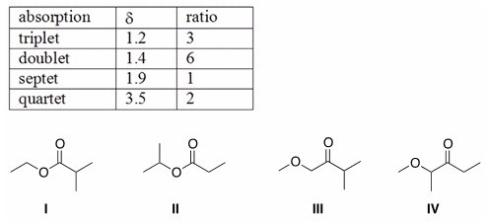
A) I
B) II
C) III
D) IV
F) A) and C)
Correct Answer

verified
Correct Answer
verified
Multiple Choice
What region of the electromagnetic spectrum does nuclear magnet resonance spectroscopy use?
A) Radio frequency
B) Microwave frequency
C) Infrared frequency
D) Visible frequency
E) Ultraviolet frequency
G) A) and D)
Correct Answer

verified
Correct Answer
verified
Multiple Choice
An unknown compound A has the molecular formula C7H14O2.Compound A absorbs strongly in the IR at 1700 cm-1.The 1H NMR spectral data for compound A are given below.What is the structure of compound A? 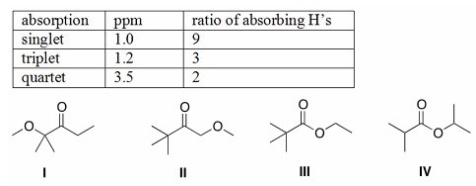
A) I
B) II
C) III
D) IV
F) None of the above
Correct Answer

verified
Correct Answer
verified
Multiple Choice
Into how many peaks will the circled proton be split? 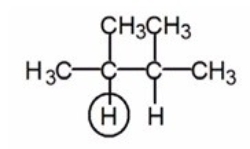
A) 5
B) 6
C) 7
D) 8
F) C) and D)
Correct Answer

verified
Correct Answer
verified
Multiple Choice
An unknown compound X has the molecular formula C7H13OBr.Compound X shows a strong peak in its IR spectrum at 1700 cm-1.The 1H NMR spectral data of compound X is given below.What is the structure of compound X? 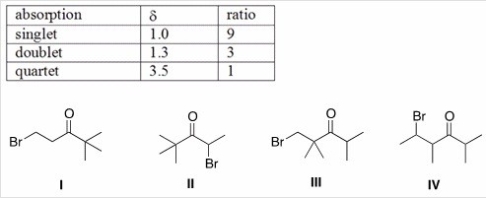
A) I
B) II
C) III
D) IV
F) C) and D)
Correct Answer

verified
Correct Answer
verified
Multiple Choice
Compound X has a molecular formula C8H10 and gives the 1H NMR spectrum below.What is the structure of X? 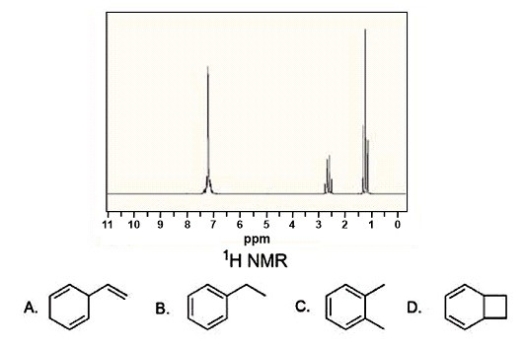
A) A
B) B
C) C
D) D
F) B) and C)
Correct Answer

verified
Correct Answer
verified
Multiple Choice
How many different kinds of protons are present in each of the following compounds? 
A) I = 2; II = 3; III = 4
B) I = 2; II = 3; III = 3
C) I = 3; II = 3; III = 3
D) I = 3; II = 3; III = 4
F) A) and B)
Correct Answer

verified
Correct Answer
verified
Showing 1 - 20 of 51
Related Exams